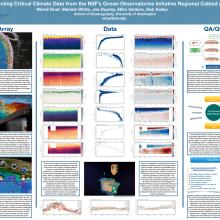Collecting Critical Climate Data from the NSF’s Ocean Observatories Initiative Regional Cabled Array
Wendi
Ruef
University of Washington
Poster
The NSF-funded Ocean Observatories Initiative Regional Cabled Array (OOI-RCA) is a state-of-the-art cabled submarine network delivering high-resolution physical, biological, chemical, and geological data from over 150 seafloor and water-column sensors since its deployment in the Northeast Pacific in 2014. Designed and maintained by the University of Washington, the OOI-RCA uses high-bandwidth optical fiber cables to provide two-way communication and real time in-situ data from a diverse set of ocean environments, including highly productive waters along the Cascadia Margin, methane seeps on the continental slope, and Axial Seamount volcano 300 miles offshore. In addition to seafloor sensors, the OOI-RCA employs innovative profiling moorings that hourly measure a multitude of oceanographic parameters throughout the entire water column spanning 2900 m water depths to ~ 5 m beneath the surface. These extraordinary interdisciplinary data co-registered in space and time are instrumental in understanding phenomena such as hypoxic events, thin layer formation, ocean acidification, and methane flux in addition to many other complexities of ecosystem variability and environmental challenges that are difficult to address using traditional ship-based sampling.
Critical to the utility of these datasets are the underlying quality assurance and quality control (QA/QC) protocols that allow users to evaluate the condition of the data and provide necessary context for robust analysis and interpretation. Here, we provide an overview of the QA/QC workflows implemented by the OOI, and the unique challenges inherent in real-time quality control of high-frequency, complex and extremely large datasets collected by RCA. We present tools and resources available to users to access data flags and annotations, ground-truthing discrete samples collected from shipboard CTD instruments and field bottle samples during annual maintenance cruises, metadata verification results, and human-in-the-loop (HITL) quality control results. Furthermore, we highlight key climate datasets available through the OOI data portal, including a decade of unparalleled high-frequency long-term time-series of pCO2 and pH data from sensors deployed on the seafloor, profiling vehicles and 200-meter platforms spanning coastal to blue water environments in the NE Pacific. These sensors provide multi-parameter datasets for investigation of biogeochemical cycling on timescales of days to weeks to years and are a top priority for continuing development of QA/QC protocols, including both QARTOD and custom QA/QC flags.
Critical to the utility of these datasets are the underlying quality assurance and quality control (QA/QC) protocols that allow users to evaluate the condition of the data and provide necessary context for robust analysis and interpretation. Here, we provide an overview of the QA/QC workflows implemented by the OOI, and the unique challenges inherent in real-time quality control of high-frequency, complex and extremely large datasets collected by RCA. We present tools and resources available to users to access data flags and annotations, ground-truthing discrete samples collected from shipboard CTD instruments and field bottle samples during annual maintenance cruises, metadata verification results, and human-in-the-loop (HITL) quality control results. Furthermore, we highlight key climate datasets available through the OOI data portal, including a decade of unparalleled high-frequency long-term time-series of pCO2 and pH data from sensors deployed on the seafloor, profiling vehicles and 200-meter platforms spanning coastal to blue water environments in the NE Pacific. These sensors provide multi-parameter datasets for investigation of biogeochemical cycling on timescales of days to weeks to years and are a top priority for continuing development of QA/QC protocols, including both QARTOD and custom QA/QC flags.

Poster file
ruef-wendi-optimizing-poster.pdf
(2.48 MB)
